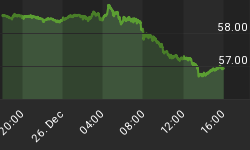In Social Security Payouts Per Worker; Accrued Interest on Accrued Promises; Imagination I posted numerous charts showing the unsustainable nature of the system.
First let's review the background, then I will address what can be done to make the system Actuarially Sound.
Here is one key chart from reader Tim Wallace followed by commentary.
Social Security Burden on Non-Farm Workers
Accrued Interest on Accrued Promises
Social Security assets are nothing but IOUs, and interest income is actually interest on money long since spent.
The entire "Trust Fund" is nothing but a promise to pay. There are no real assets (other than the ability to raise taxes to meet current expenses). Everything else is just a promise, and even more absurdly, accrued interest on accrued promises.
The chart provided by Wallace should give everyone second thoughts about the ability to raise taxes to meet expenses.
Imagination
The key point is Social Security is now cash flow negative although imaginary assets have increased in value, based on imaginary interest, and imaginary ability of taxpayers to forever keep meeting escalating payouts.
Here is another chart from my earlier post Social Security Trends: Beneficiaries, Total Costs, Number of Workers, Ratio of Workers to Beneficiaries
Total Annual Cost of Social Security 1967-Present

Social Security Beneficiaries vs. Total Non-Farm Employment
Here is the chart from the Social Security Administration that shows the system is cash-flow negative even though alleged assets have increased in value.
Trust Fund Data
Payroll Tax Cut
The system turned cash flow negative in Fiscal Year 2012, far earlier than anyone expected, primarily because of the payroll tax cut. However, that cut was rescinded in the Fiscal Cliff agreement so the system will temporarily be back in the green this year.
Looking ahead, and ignoring accrued interest on imaginary assets what can be done to make the system solvent?
Actually, Social Security is not that difficult a problem, except for the politics of it all. Numerous things could be done to put the system in the green.
Possible Ways to Make Social Security Actuarially Sound
- Raise retirement age
- Raise or eliminate the cap on payroll taxes
- Cut benefits
- Collect Social Security on personal income
- Implement a Tiered Cap structure
- Means Testing
Democrats would oppose 1 and 3. Republicans might oppose all but 3. Pragmatists might want to do all of them.
Business Point of View
Let's leave politics aside and discuss this from a business point of view. Is it possible to decrease the burden on businesses while not hurting those making less than $250,000 a year?
There is no free lunch of course, but think about the possibility of a tiered cap structure.
- Leave the existing tax cap as it is, but after a gap (at say $250,000 or $500,000) start collecting taxes again.
- No business contribution on amounts collected on the highest tier.
- Reduce business contributions across the board by 33% of the additional revenues collected on the highest tier
This would get revenue Democrats desperately want, while also reducing burden on businesses that Republicans desperately want. Businesses would benefit, and the only cost would be to those making above the gap.
Who Benefits?
- Large and medium-sized businesses would easily benefit from lower payroll taxes.
- Small business owners making less than the top cap would benefit from reduced payroll taxes.
- Small businesses owners making more than the top tier might still benefit more from reduced corporate taxes than they lose in personal taxes (provided they have enough employees).
The only losers in this proposal are those making more than the top gap, while not hiring enough employees to make up the difference.
In Return
In return for agreeing to this hike in revenues, Republicans could and should demand benefit cuts, a raise in retirement age, cuts in Medicare, or some other incentive.
Means Testing
Social Security was meant to be an insurance program for those unable to take cared of themselves after retirement. As such, should anyone with hundreds of thousands of dollars in annual interest income or millions of dollars in liquid assets collect social security payments after retirement?
If not, those disbursements not paid out can also be used to reduce taxes on businesses or to increase survivor benefits.
Pragmatism vs. Beliefs
In general, I am against tax hikes.
As a pragmatist, I believe tax hikes are coming regardless of whether or not they should. My proposal has the advantage of offering something to Republicans, something to Democrats, and a lot to businesses, only impacting those making more than the top cap (which of course should be inflation-adjusted).
By the way, this line of thinking can be applied to things other than just social security. A portion of all tax hikes can go to reduced payroll tax burdens on businesses.



















